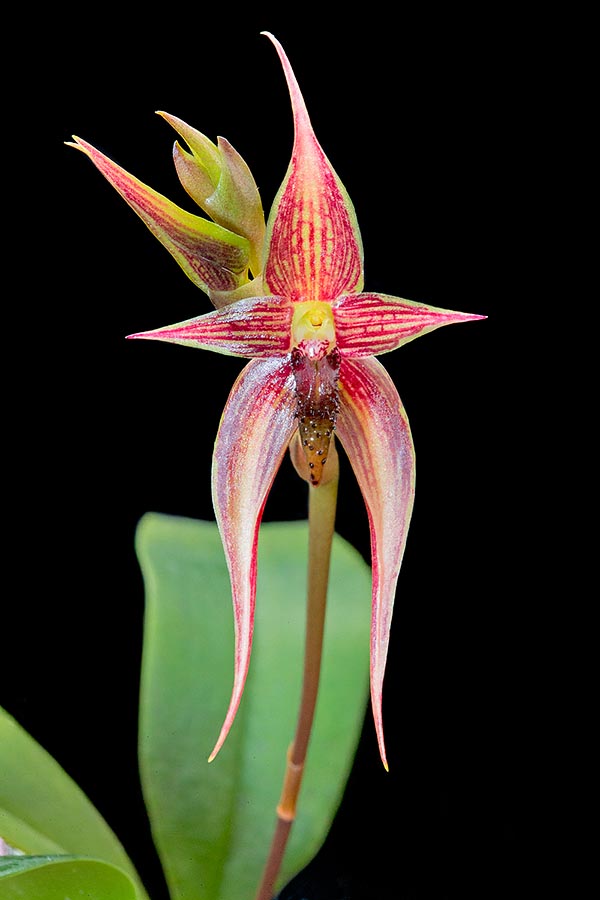Family : Orchidaceae

Text © Pietro Puccio

English translation by Mario Beltramini

Epiphyte of the forests of the Indonesian island of Sulawesi, Bulbophyllum vanvuurenii stands among the genus most ornamental species. Showy sequentially flowers about 10 cm long, but rare in cultivation © Giuseppe Mazza
The name of the genus is the combination of the Greek substantives “βολβός” (bolbos) = bulb and “φύλλον” (phyllon) = leaf, with reference to the leaves growing at the apex of the pseudobulbs; the species is honoured to the Dutch botanist and collector Louis Van Vuuren (1873-1951).
The Bulbophyllum vanvuurenii J.J.Sm. (1917) is an epiphytic species with ovoidal pseudobulbs, 3,6-4 cm long and 3 cm broad, spaced of about 1,5 cm on a creeping rhizome rooting at the nodes and provided of one only elliptic to oblanceolate leaf with pointed apex, 24-28 cm long and 5-6 cm broad.
Erect inflorescence from the base of the pseudobulb, 30-50 cm long, bearing up to 8 flowers opening in succession, about 10 cm long, with sepals and petals of cream yellow colour with purple red longitudinal stripes and dark red labellum.
Lanceolate dorsal sepal with long pointed apex, about 4 cm long and 1,2 cm broad, lancelate lateral sepals with long pointed apex, falcate, 4,2-4,6 cm long and about 1 cm broad, lanceolate petals with pointed apex, about 2 cm long and 1 cm broad, fleshy, warty labellum, with two parallel crests at the base, 1,8 cm long and 0,5 cm broad, and column, 0,8 cm long, with two teeth on the sides of the anther. It reproduces by seed, in vitro, and by division with each section provided of at least 3-4 pseudobulbs.
Species among the most ornamental of the genus, but quite rare in cultivation, requires medium-high temperatures, 22-32 °C, high humidity, 75-85%, and constant ventilation; a daily temperature range of the least 4-5 °C fosters the blooming.
Regular and abundant waterings, but allowing the substratum to slightly dry up before giving water again, during the growth period, more spaced during the vegetative rest, but without ever letting the substratum to dry up completely, utilizing rain water, demineralized or by reverse osmosis. For the fertilizations may be utilized a balanced hydrosoluble product, with microelements, at ¼ the dosage, or less, of what suggested, with monthly frequency.
It can be mounted on trunks or rafts of cork or of roots of arborescent ferns, with sphagnum at the base in order to maintain the humidity, or placed in pots or baskets with medium-sliced bark or coir. Transplants and repottings, when necessary, are to be done at the vegetative restart.
The species is reported in the appendix II of CITES (species whose trade is internationally ruled).
Synonyms: Bulbophyllum paluense Garay ex W.E.Higgins (2009).
→ For general notions about ORCHIDACEAE please click here.
